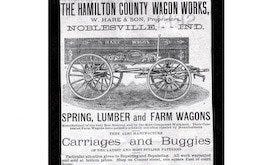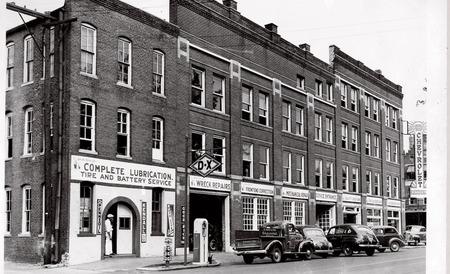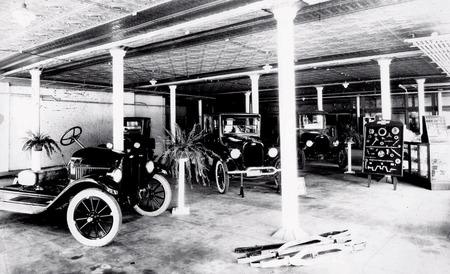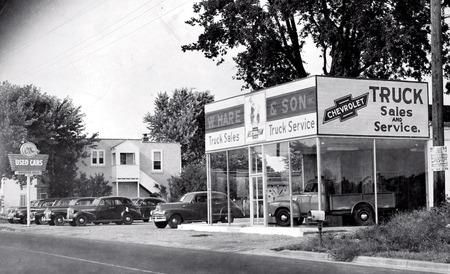What Molars Come in at Age 14
In 1847, Americans were about to begin a headlong rush to California to pan for gold. Those who had money could sail from New York to San Francisco via clipper ships—so called because the vessels clipped so much time off a passage. In fact, the trip took "only" 89 to 105 days. But your average Joe, a guy who had real time on his hands, usually made the trip via horse-drawn wagon.
______________________________________

______________________________________
Which worked out swell for 22-year-old Wesley Hare, the son of German immigrants who lived in Noblesville, Indiana, a few miles northeast of Indianapolis. There, in a log cabin in 1847, Wesley was wielding broadaxes, mallets, chisels, and augers to fashion all manner of wagons, carriages, and buggies. He felled the necessary timber himself. His carriages were hot stuff, especially the "Fancy Cutunder Roll-Back Auto Seat Buggy," the "Queen Phaeton," and the "Roll-Back Canopy Surrey." What's more, Wesley was something of a marketing whiz—all of his vehicles came with a one-year warranty on axles, wheels, and springs.
Given the looming vehicular needs of the forty-niners, the local farmers, and the Union Army, Hare quickly became one busy artisan, employing 45 men. His was the largest company in little Noblesville.
Just after the Civil War, a man's hand-tailored suit cost $15, and Wesley would surely have had a closetful. By 1900, there were 109,000 carriage and harness makers in the U.S. But by then, Wesley had already made his fortune and had handed the business to his son Elbert, known as "E.M." [See "Generations" sidebar on page 90.]
The company was now officially W. Hare & Son (www.hareauto.com) and moved from the log cabin to an imposing 45,000-square-foot four-story brick building one block from the courthouse. It was the second-largest structure in Noblesville and was fitted with a Midwest luxury: an elevator. E.M. continued practicing his father's craft, eventually turning out 700 buggies annually. But then a funny thing happened. Backyard mechanics nationwide began installing engines in buggies and wagons. These so-called "horseless rigs" were mostly experimental and, prior to blowing up, usually scared the riders as much as nearby livestock. Nevertheless, E.M. felt he might be able to sell a few of the oily contraptions. His employees were outraged, insisting that motorized buggies were a fad and that horses, not metal, would always supply horsepower. E.M. wasn't persuaded. He sold buggies alongside primitive automobiles for three years before the latter proved to be the profit center, just as he'd guessed. After running the company for 20-some years, he signed contracts with Hupmobile, Studebaker, and Cadillac. By 1912, automobiles comprised the majority of the company's business.)
And thus began a dynasty.
W. Hare & Son would eventually be managed by six generations of Hares, all of them selling anything connected to four wheels, mostly Chevrolets. "If you're born a Hare, you sell cars," says 62-year-old Jackie Hare, who today co-owns the company with husband Dave Cox. "It's earned us the right to advertise ourselves as America's oldest continuously family-owned transportation company—162 years and counting."
"We've done well, but this has always been a hard business," asserts Cox, who started as a parts-delivery gofer for Jackie's father 43 years ago. "Every store the family has owned, right back to the founder's, has weathered bleak times—wars, no cars to sell, the Depression, fuel shortages, 18-percent interest rates. To cover his bases, E.M. sold maple syrup and was president of the Home Telephone Company [in 1899]. Back then, the dealership's telephone number was 14." Even Bill Hare, after he signed to sell Chevrolets exclusively in 1921, sold just 20 to 30 cars per year—for eight years.
In 1924, Willard "Bill" Hare, earlier a semipro baseball player, staged his own endurance run to publicize the dealership (pictured right).
"During the Depression," notes Jackie, "Chevrolet insisted my grandfather buy a huge sign for out front. It almost bankrupted him. He was bitter about that, always."
Even taking delivery of the automobiles was hard work. New vehicles—sans wheels and fenders—arrived via train. The cars were stacked on end, noses pointing skyward. It was the dealer's responsibility to assemble the cars at the rail yard and drive them back to the showroom. In 1919, Bill Hare, desperate for sales, ran a newspaper ad listing all of his former customers' names and addresses. Would-be buyers could thus contact previous buyers to determine whether they'd been treated fairly. The Hare archives contain a receipt for a 1928 Chevy sedan that Bill sold. Price: $675, not including shipping ($40), bumpers ($22.50), and a spare tire ($16.50). Nor did it include a vital item that its buyer would require: an Indiana driver's license (25 cents when the state first issued them in 1929). In another ad, Bill boasted of his repair shop's paint: "We rely on white oil and lead."
________________________________________________________________

________________________________________________________________
It is likely that no Hare, however, had it tougher than Jackie's father. In the early '40s, just as Jack Hare was becoming established at his father's dealership, Chevrolet ceased production of automobiles in support of the war effort. Jack bought as many existing cars as he could and parked them on blocks in the three floors above the showroom. Then he went off to win a medal flying the "Hump," the deadly India-to-China supply route over the Himalayas.
"They had no new cars to sell for three and a half years," says Cox, "and during that time, the dealership had exactly two employees. Jack refused to sell his surplus cars for fear it would look like he had hoarded them to sell at a profit. To stay solvent, his employees sold all the tires off the new cars, then drove to Cleveland every week with a load of bald tires they'd get retreaded. Back then, tires lasted 4000 miles." Meanwhile, they sold lube jobs for 95 cents and tuneups for $2.95.
Bill Hare questioned his son's purchase of the surplus automobiles, remarking, "You're brilliant if we win the war, but what if we lose?" Jack answered, "Then it won't matter." When peace broke out, father and son sold the "new" cars they'd stored at fair prices. "You gouge someone in a small town like this," says Jackie, "and everyone knows in 24 hours."
Having had so close a brush with financial ruin, Jack Hare hedged his bets ever after, buying a Westinghouse appliance store, which he situated next to his car showroom. "And for the rest of his life," recalls Jackie, "he'd lose sleep when GM or Firestone [then Noblesville's largest employer] went on strike. He was also terrified that, in the late '50s, antitrust legislation would break up GM, and that Chevrolet would be sold off. That would have killed him. He was a Chevy man, through and through, wouldn't drive an Oldsmobile to save his life. He said, 'You dance with the one who brought you.'"
Every man, woman, and child in town knew Jackie's father and grandfather and spoke to them on the streets, in the grocery, at church, and in restaurants. Except for founder Wesley, every Hare was born in Noblesville and attended Noblesville schools. As leading citizens, they were expected to perform good deeds and did. Dave and Jackie recently helped construct the high-school football field, now called Hare Field, and founded a women's pavilion at the local hospital.
At a time when the dealership was selling only 20 to 30 new cars per year, a towing service bolstered the bottom line. Notice the phone number: 14 (pictured right).
"Cars were sold so differently back then," recalls Jackie. "In my grandfather's day, a customer would come in and just sit for two hours, and they'd talk about sports, weather, the price of corn. But they'd never mention an automobile. Then the customer would come back, maybe talk a second day. And on the third day, they'd get down to dickering about a car. But it was all cautious, deliberate, very polite."
"In the '30s and '40s [when a pound of coffee cost 13 cents], it was unheard of for a salesman to spend the whole day in the showroom," says Cox. "You could get fired for that. Bill and Jack probably sold more cars in the town square than in the dealership. On Saturday night, the whole town would mingle around the square and socialize, and the salesmen would hope the conversation would turn to cars. But they wouldn't bring it up first, because that would be rude. Even in the early '60s, when I started, the salesmen were expected to attend church suppers and high-school sports events and greet farmers out in their fields. The farmers would only come into the dealership in September and October, after they'd sold their crops, and they'd have a wad of cash in their overalls. Those were our best months. I've always believed that's why new cars were historically rolled out in the fall."
________________________________________________________________

________________________________________________________________
Back then, the dealership's salesmen were much older than they are nowadays. It was assumed older men were wiser and more trustworthy. "We had a salesman who worked for us for 55 years—he was selling Oldsmobiles when he was 80," recalls Cox. "Bill and Jack's dealerships also sold a ton of accessories—batteries, tires, inner tubes, hub caps, chrome trim, bumpers, heaters, radios, even hood ornaments. There was real money in that. And on payday, everyone got an envelope with his name on it, and there'd be cash inside. It was done out of consideration for the older guys who still mistrusted banks and didn't have savings accounts."
But it's been in the past 30 years that the greatest changes have transpired. "For one thing, folks stopped custom ordering cars from the factory," notes Cox. "Plus, there's no loyalty to brands anymore, maybe with the exception of trucks. We used to compete with almost nobody. Now, as people have become so mobile and willing to travel to adjacent counties, we compete directly with 17 Chevrolet stores. People don't even shop the same," he adds, pointing to the huge showroom floor, which today contains only two cars—a Malibu and a Corvette. The rest of the space is occupied by salesmen's cubicles. "People like to examine the cars outdoors now. They stroll up and down the whole row of Malibus, for instance, to see what's available. I think it's a psychological thing, sort of like circling the dealership so you know what you want before entering, where you'll have to go one on one with a salesman."
As Jackie grew up, she recalls being terrified of the huge elevator at her grandfather and father's dealership, but she toiled at all manner of jobs. "As a teen, I even tried being a service writer," she recalls. "I was terrific at greeting people—they loved me. But I could never figure out how long to schedule any particular service. New shocks? Was that 10 minutes or two hours? I had to ask. People are too impatient for that now. When they come in the door to buy a car, they want to be driving it home in 90 minutes."
The current 50,000-square-foot Noblesville dealership, featuring 50 service stalls, was built in 1999 (pictured right).
Her husband adds, "And they're less and less interested in face time, in connecting with who we are," although that's not always a bad thing. He recalls an irascible mechanic who started with the company in 1947 and stayed 55 years: "A reporter came to interview him. He threw a shop rag in the reporter's face, said he was asking dumb questions. An OSHA inspector got down in a pit with him beneath a car, and the mechanic cursed at him, then tossed him out, screaming, 'You're in my way!' To us, he was just one of life's colorful characters."
Today, GM sends its emissaries to the dealership to ensure that décor, paint schemes, restrooms, and signage toe the corporate line. Originality is not encouraged. The salesmen are trained to sell cars via a structured regimen, "a code of psychology and salesmanship that has been studied to death," says Cox. "It's what works the fastest, most effectively, but it can sometimes leave the buyer feeling manipulated."
________________________________________________________________

________________________________________________________________
Noblesville's town square still looks like the town square in the movie Back to the Future. The courthouse is surrounded by small, thriving businesses—cafés, a jeweler, a furniture store, Syd's Bar. But the town is now a bedroom community for Indianapolis. As such, the stand-alone Chevy store that Jackie and Dave built in 1999 is a sophisticated and cosmopolitan whopper. It offers 50 service stalls, a photo booth for online ads, 50,000 square feet of surgically clean floor, and 150 employees. Outside sit 1000 to 1200 new Chevrolets, of which 300 or so are sold per month.
Inside, there remain vestiges of history—two 1870s-era Hare buggies, built just as Thomas Edison was inventing the light bulb. The showroom's walls are adorned with a 90-foot-long hand-painted mural depicting the family's history. And the blue bow-tie sign out front still reads, "W. Hare & Son."
Recently, the sun cast a perfect shadow of one of the buggies on the showroom's upper wall. "It was eerie," Jackie recalls. "It was as if Wesley—who'd be 183 years old now—was beaming down from above."
"Every day, I feel the ghosts of Hares past," adds Cox. "Like them, I lose sleep at night. I look out on my lot, and I might have $15 million to $20 million worth of cars out there that I'm financing. What if they don't sell? What if it hails or floods or another manufacturer introduces a car that makes one of my models look lame? The public doesn't realize the risk we take for the return we get on each car. I know we look like a national chain, but this is just a family operation. That it has survived for 162 years is a fluke. It could have gone out of business 20 times, been sold to rivals 20 times, been mismanaged to death 20 times. But it never was. That simply stuns me."
This content is created and maintained by a third party, and imported onto this page to help users provide their email addresses. You may be able to find more information about this and similar content at piano.io
Source: https://www.caranddriver.com/features/a15143521/a-dealership-for-the-ages/